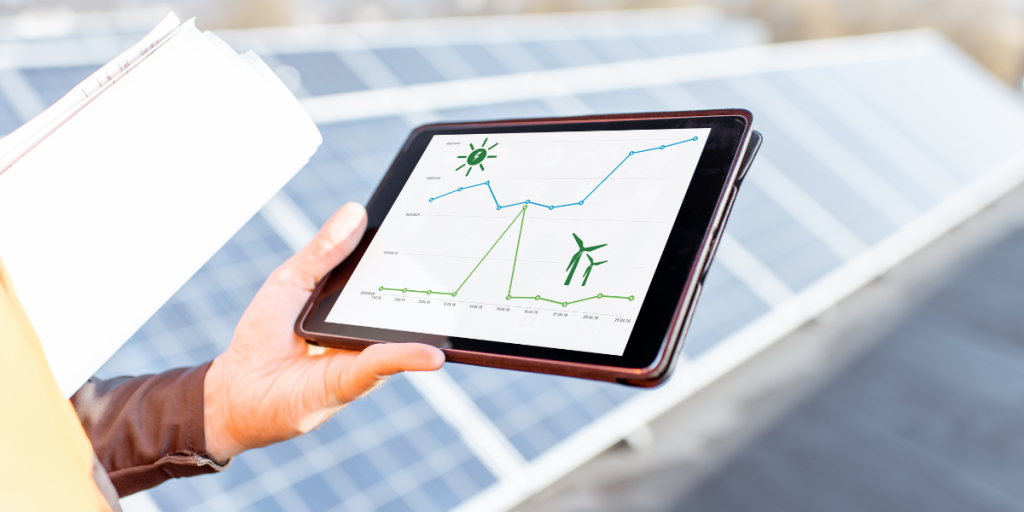
Table of Contents
Introduction
Let us explore how Power BI for the energy sector can analyze and visualize data to gain more significant insights into its operations and performance, resulting in more informed decisions based on actual data.
Abraham Lincoln quoted in 1860, “As yet the wind is an untamed, unharnessed force, and quite possibly one of the greatest discoveries hereafter to be made will be the taming and harnessing of it.”
He envisioned that wind energy would play a significant role in renewable and sustainable energy. And his predictions are accurate.
As per research, the amount of electricity generated by wind increased by almost 273 TWh in 2021 (up 17%), 55% higher growth than that achieved in 2020. It is also the largest of all power generation technologies. Wind remains the leading non-hydro renewable technology, generating 1870 TWh in 2021, almost as much as all the others combined.
Therefore, not only is the renewable sector playing a significant role in making the planet healthy, but also harnessing the potential of natural elements to create energy for us.
But with the ever-increasing demands and needs of the growing population, this sector must also digitalize itself to keep up with them. They constantly need to evolve and update themselves about their data and numbers. And thanks to technology, they can do it seamlessly and efficiently.
Let us dig deeper into how the renewable sector can analyze and visualize data to provide them with more significant insights into their operations and performance, resulting in making more informed decisions based on actual data.
Data Challenges of the Renewable Energy Sector
The data collected by the renewable energy sector is unimaginable. It has to be operational 24 x 7 and 365 days to ensure the earth has balanced energy, reduced use of fossil fuels, and fewer global warming issues.
Therefore it faces several data challenges, some of which are listed below.
Data Collection
The renewable energy sector generates a massive amount of data, including information from sensors, weather stations, and energy meters. Collecting, organizing, and analyzing this data from various sources is essential for optimizing energy generation, but it can be challenging to do so efficiently.
Data Quality
Data accuracy is crucial to the effective functioning of renewable energy systems. However, data quality issues such as sensor malfunctions, communication errors, and data loss can cause significant problems, leading to inaccurate forecasting, inefficient operations, and higher costs.
Data Integration
Various technologies and systems, such as wind turbines, solar panels, and energy storage units, characterize the renewable energy sector. Integrating these systems and their corresponding data streams can be challenging, particularly in heterogeneous environments.
Data Management
Managing large volumes of data generated by renewable energy systems can be challenging, particularly given the need for real-time data processing. Proper data management practices, including data storage, backup, and security, are necessary to ensure the reliability of renewable energy systems.
Data Analytics
Analyzing the vast amounts of data generated by renewable energy systems can be challenging, particularly given the complexity of the systems and the high volume of data. Advanced analytics tools and techniques like Power BI energy consumption dashboards are necessary to extract insights from this data and to improve system efficiency and reliability.
With constant changes amounting to the work and data load for the renewable sector, the sector needs real-time, flexible, and scalable solutions. And the solution is Power BI visualization services for renewable.
What is Power BI?
Power BI is Microsoft’s highly advanced tool that connects with various data sources to represent data visually. These visuals are represented on interactive and personalized dashboards to identify information and make decisions quickly. Thus, data is converted to meaningful insights in the most seamless way. Power BI lets your business visualize its strengths and weaknesses, allowing you to take intelligent business steps.
The Power BI platform;
Power BI is widely used by businesses of all sizes and industries to gain insights into their data and make informed decisions. Therefore it can help the renewable energy sector with business intelligence and analytics. Read the following section to learn how.
Digitalizing the Renewable Energy Sector
The initial introduction of Power BI may paint a picture of it being a corporate tool. But we want to clarify that every business can and must incorporate Power BI for informed decision-making.
Power BI for energy industry will monitor and analyze their energy production and consumption data in real time, which is critical for optimizing energy efficiency and reducing costs.
Here are the details of how Power BI integration for energy will help solve data challenges in the renewable energy sector.
We understand that writing the solutions and challenges is far easier than implementing them. Plus, in theory, everything is managed. So is there an example that supports the idea of green data centers? Surprisingly, we have one!
Complete Digitalization
With complete digitalization and BI software for energy, the renewable energy sector can monitor and control its energy production and consumption systems remotely. This can include real-time monitoring of energy generation, consumption, and storage systems.
Manage Large Volume Of Data
Power BI allows businesses to analyze large volumes of data quickly and easily, providing valuable insights into their operations. This can help the energy sector to make informed decisions based on real-time data, leading to better performance and increased efficiency.
Predictive Analytics
Power BI offers predictive analytics capabilities, allowing businesses to forecast future trends and patterns in their data. This will help the renewable energy sector plan for future needs and optimize its operations according to the changes and rise in demand.
Cost Savings
Analyzing large volumes of data through Power BI can lead to cost savings by identifying areas where resources can be optimized. For example, the data can indicate if particular solar panels are not absorbing energy as they should. Thus, the organization can repair or check the panels in time. This saves costs for replacement or further damages.
Enhanced Data Collaboration
Power BI in energy makes it easy for teams and departments to collaborate and share data, enabling better organizational communication and decision-making. So, no more confusion between the on-site employees and the corporate folks!
The power of Power BI cannot be incorporated into a single blog. But by utilizing it, the renewable sector can access the outage effect, achieve compliance, and enhance sales, marketing, and revenue generation.
A Story
In a meet-up, Muen Chen of SA Power Networks explained how the Power BI dashboard helps maintain powerline assets and saves bird nests. We know that birds create nests at the top of pole powerlines, which creates a potential fire hazard. Therefore, Muen’s dashboard helped to identify when and where nests are found.
See how even the little things can be taken care of. The BI intelligence platform can help humans and nature walk together hand in hand without destroying the other for their needs!
Power BI + Renewable Energy Sector = Greener Planet
When combined with the renewable energy sector, Power BI has the potential to contribute to a greener planet in several ways.
Power BI can monitor and track renewable energy production, such as solar, wind, hydro, and geothermal.
Tracking energy usage patterns on the sustainability dashboard Power BI can identify areas where energy is being wasted, and measures can be taken to reduce energy consumption.
Power BI energy dashboard can identify patterns that can be used to mitigate environmental risks and improve sustainability practices.
This incorporation will lead to a greener planet and reduce our reliance on non-renewable energy sources while minimizing our environmental impact.



